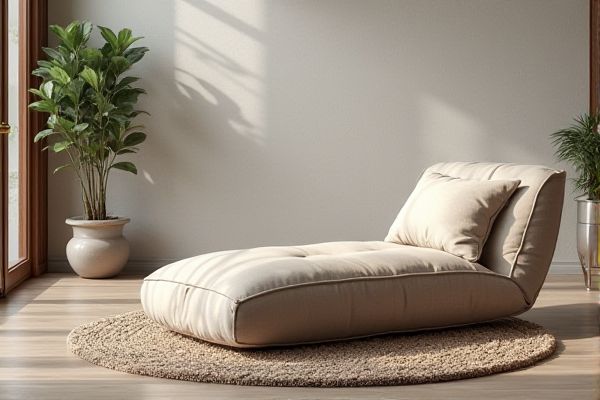
A pouf is a soft, upholstered, and often cushioned piece of furniture used for seating or as a footrest, typically smaller and lighter than a floor ottoman, which tends to be larger, sturdier, and can double as storage or a coffee table. Explore the article to discover which option suits Your living space and style preferences best.
Table of Comparison
| Feature | Pouf | Floor Ottoman |
|---|---|---|
| Design | Soft, stuffed, often round or irregular shapes | Structured, rectangular or square, with firm padding |
| Function | Footrest, extra seating, decorative accent | Footrest, seating, additional storage (in some models) |
| Size | Typically smaller and lightweight | Larger and sturdier |
| Material | Fabric, leather, knitted covers | Upholstered in fabric or leather, often with wooden frame |
| Portability | Easy to move due to light weight | Less portable, heavier and bulkier |
| Storage | Generally no storage feature | Some models include internal storage space |
| Price Range | Usually more affordable | Varies, often higher due to frame and storage |
Understanding Poufs: Definition and Features
Poufs are versatile, cushioned pieces of furniture that serve as both seating and decorative accents, typically characterized by their soft, stuffed design without legs. Unlike floor ottomans, which often have a more structured frame and may include storage, poufs emphasize lightweight portability and plush comfort. Crafted from various materials such as knitted fabric, leather, or cotton, poufs add texture and style while providing flexible functionality in living spaces.
What is a Floor Ottoman? Key Characteristics
A floor ottoman is a low-profile, upholstered piece of furniture designed for seating or resting feet, often without legs to create a grounded look. Key characteristics include a sturdy frame, soft cushioning, and versatile use as a footrest, extra seating, or even a coffee table alternative. Unlike traditional poufs, floor ottomans typically have a more structured form and can incorporate storage compartments or trays for added functionality.
Design Differences: Poufs vs Floor Ottomans
Poufs typically feature a soft, cushion-like design with rounded shapes and skinnier profiles, often upholstered in fabric or knit materials that emphasize comfort and portability. Floor ottomans generally have a sturdier, box-like construction with firmer padding and wooden or metal legs, providing both seating and additional storage options. The design differences highlight poufs as lightweight accent pieces, while floor ottomans serve multifunctional roles in living spaces.
Material Comparison: Durability and Style
Poufs are typically crafted from knitted cotton, woven wool, or leather, offering a blend of softness and casual style, while floor ottomans often feature sturdier materials like solid wood frames upholstered with durable fabrics or leather for enhanced longevity. The knitted or woven textures of poufs contribute to a cozy, relaxed aesthetic but might wear faster under heavy use, whereas the solid construction of floor ottomans provides better support and durability, making them ideal for both seating and storage. Considering Your lifestyle, choosing between a pouf's lightweight flexibility and a floor ottoman's robust build will affect both the durability and style impact in Your living space.
Comfort and Functionality: Which is Better?
Poufs offer lightweight, versatile comfort with soft cushioning, ideal for casual seating or footrests in compact spaces. Floor ottomans provide firmer support and often incorporate storage solutions, enhancing functionality for living rooms or bedrooms. Your choice depends on whether you prioritize portability and cozy lounging or structured seating paired with practical storage.
Best Uses for Poufs in Home Décor
Poufs serve as versatile accents in home decor, perfect for adding extra seating or a cozy footrest in living rooms and bedrooms. Their lightweight design allows you to easily move them around to create flexible seating arrangements or casual lounging spots. You can also use poufs as stylish side tables by placing a tray on top, enhancing both functionality and aesthetic appeal in your space.
Floor Ottomans: Versatility and Practicality
Floor ottomans offer unparalleled versatility and practicality in home decor by serving as multipurpose furniture pieces that function as extra seating, footrests, or even coffee tables. Their sturdy construction and often larger, flat surfaces accommodate various uses, making them ideal for small spaces and flexible living arrangements. Unlike poufs, which are typically softer and less structured, floor ottomans combine comfort with functional storage options, enhancing both aesthetic appeal and organizational efficiency.
Space Considerations: Pouf vs Floor Ottoman
Poufs are typically smaller and lightweight, making them ideal for compact spaces where flexibility and easy mobility are essential. Floor ottomans tend to be larger and offer more surface area, providing both seating and storage options but requiring more floor space. Choosing between the two depends on room size constraints and multifunctional furniture needs for optimal space utilization.
Maintenance and Cleaning Tips
Poufs made of fabric require regular vacuuming and spot cleaning with mild detergent to maintain their appearance, while leather poufs benefit from wiping with a damp cloth and conditioning to prevent cracks. Floor ottomans, often upholstered in durable materials, can endure more frequent cleaning methods such as steam cleaning or professional upholstery treatments. Both poufs and floor ottomans should be rotated periodically to ensure even wear and extend their lifespan.
Choosing Between a Pouf and a Floor Ottoman
Choosing between a pouf and a floor ottoman depends on your space and functionality needs. Poufs are typically lighter, versatile, and easy to move, perfect for casual seating or footrests in smaller areas. Floor ottomans offer more structure and storage options, ideal for multi-use furniture in living rooms or bedrooms where you need both comfort and organization.
 homyna.com
homyna.com